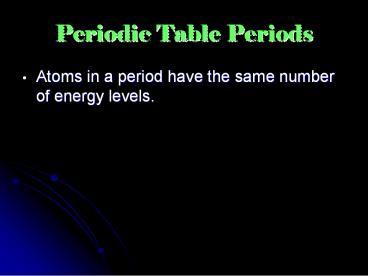Periodic Table Periods - PowerPoint PPT Presentation
1 / 21
Title:
Periodic Table Periods
Description:
Periodic Table Periods Atoms in a period have the same number of energy levels. Periodic Table Groups Many groups have special names that describe their characteristics. – PowerPoint PPT presentation
Number of Views:149
Avg rating:3.0/5.0
Title: Periodic Table Periods
1
Periodic Table Periods
- Atoms in a period have the same number of energy
levels.
2
Periodic Table Groups
- Many groups have special names that describe
their characteristics. - Atoms in a group have same number of valence
electrons so they behave similarly. - Roman numerals represent the number of valence
electrons.
3
Terms to Know
- Cations refer to the elements that lose electrons
and form a positive ion. - Anions refer to the elements that gain electrons
and form a negative ion.
4
Alkali Metals
- All form 1 cations
- Very reactive with water
- Highly reactive in general
5
Alkaline Earth Metals
- All form 2 Cations
- Somewhat reactive with water
- Highly reactive with acids.
6
Halogens
- All form -1 Anions
- Aggressive Oxidizers
- Used in Halogen bulbs.
7
Noble Gases
- Non-reactive
- Fulfilled Octet Rulehave 8 valence electrons in
the outer most energy level and considered stable.
8
Other Groups
- Group 13 (IIIA) Boron Family
- Form 3 Cations
- Group 14 (IVA) Carbon Family
- Form 4 Cations or Anions
- Group 15 (VA) Nitrogen Group
- Form -3 Anions
- Group 16 (VIA) Oxygen Family
- Form -2 Anions
9
Periodicity
- When elements are arranged in order of increasing
atomic number, there is a periodic repetition of
their physical and chemical properties. - An important consequence is that the elements
with similar chemical and physical properties end
up in the same column. - Trends on the periodic table govern how elements
behave chemically. - All elements are unique, but follow these
trends.generally.
10
Atomic Size/Atomic Radius
- Atomic radius is ½ the distance between the
nuclei of identical atoms that are bonded
together. - Group Trend size INCREASES as you move down
(added energy levels electrons farther from
nucleus). - Period Trend size DECREASES as you move left to
right (more protons and electrons pulling harder
on one another). - Due to increasing energy levels and shielding by
inner electrons. Inner electrons shield the
outermost electrons from the nucleus.
11
Atomic Size Cont.
12
Examples
- Which atom has the larger radius?
Be or Ba Ca or Br
Ba Ca
13
Ionic Size/Ionic Radius
- Ionic Radius is the relative size of the most
common ion of an atom. - Group Trend INCREASE top to bottom due to
shielding. - Cations are always smaller than their neutral
atom - Loss of electrons increase attraction
- Anions are always bigger than their neutral atom.
- Gain of electrons decrease attraction
- Period Trend DECREASE left to right.
14
Electronegativity
- Electronegativity is a measure of the ability of
an atom in a chemical compound to attract
electrons when they are chemically combined with
atoms of another element. - Group Trend DECREASE as you move down due to
increasing number of energy levels. - Period Trend INCREASE from left to right right
due to switch from cat ions to anions. - Fluorine has an electronegativity of 4.0,
everything below and to the left is lower.
15
Electronegativity
16
Electronegativity
17
Ionization Energy
- Ionization Energy is the energy required to
overcome the attraction of the protons and remove
one electron from a neutral atom of an element . - The energy required to remove the 1st outermost
electron is call the 1st ionization energy. And
the energy for the 2nd outermost electron to be
removed is called 2nd ionization energy. - Atoms may have 2nd or 3rd ionization energies
depending on number of valence electrons and
adherence to octet rule.
18
Ionization Energy
- Group Trend ionization energy DECREASES as you
move down (electrons further from the pull of the
nucleus are easier to remove). - Period Trend ionization energy INCREASES as you
move left to right (greater attraction of the
nucleus for electrons).
19
Ionization Energy Cont.
20
Examples
- Which atom has the higher 1st I.E.?
N or Bi Ba or Ne
N Ne
21
Summary of Periodic Trends































